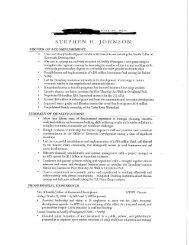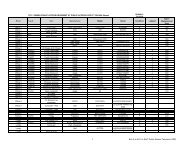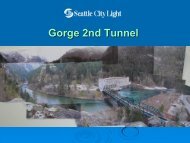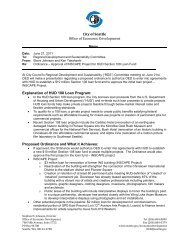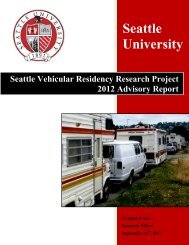2013 Water System Plan, Volume II - Seattle City Clerk's Office - City ...
2013 Water System Plan, Volume II - Seattle City Clerk's Office - City ...
2013 Water System Plan, Volume II - Seattle City Clerk's Office - City ...
You also want an ePaper? Increase the reach of your titles
YUMPU automatically turns print PDFs into web optimized ePapers that Google loves.
Chapter 5 <strong>Water</strong> Infrastructure<br />
3. The surface below the air gap must slope away from the storage cell and direct the<br />
flow to a sump or catch basin from which the flow is conveyed to the designated<br />
discharge point.<br />
The following are guidelines for overflow pipes:<br />
If the overflow water enters a sewer, check sewer pipe hydraulics for any constraints<br />
to accepting the design overflow rate.<br />
If the overflow water can enter a natural stream or pond directly from the discharge<br />
point, a passive dechlorination system should be installed. For example, a passive<br />
dechlorination system is a catch basin within which bags of a dechlorination<br />
chemical (ascorbic acid or sodium thiosulfate) are placed. The overflow water is<br />
passed through the dechlorination structure before discharge to the receiving water<br />
body.<br />
In addition to a screen, consider installing a flap gate or duckbill valve at the end of<br />
the overflow pipe to prevent animal access.<br />
Note: Overflows usually go to a reservoir’s dedicated storm drain line. This line must also be<br />
capable of the flow rate. The receiving water body must likewise be able to receive this flow rate.<br />
5.9.5.5 Connections<br />
Connections between the storage cell structure and pipes external to the structure (either<br />
exposed or buried pipes) should allow for longitudinal expansion and lateral movement that<br />
occurs during earthquakes and through long-term differential settlement. Pipes located under<br />
ground-level reservoirs should be encased in reinforced concrete to minimize future<br />
maintenance.<br />
5.9.5.6 Hatches<br />
The following are SPU standards for water storage hatches:<br />
1. All access hatches not bolted to the main structure must be lockable and provide<br />
intrusion switches linked to the SCADA system.<br />
2. Hatch lids must be designed to prevent drainage runoff from entering interior of the<br />
hatch and/or accumulating next to the hatch area. This also provides protection<br />
from ice damage. For hatches with raised curbs or frames, the lid should overlap the<br />
curb/frame.<br />
The following are guidelines for hatches:<br />
For accessible ground-level hatches to concrete reservoirs, the hatch should be<br />
designed either to lock or to accommodate a 600-lb block or lid on top.<br />
Hatches manufactured by LW Products or Bilco have typically met SPU requirements.<br />
Hatches installed in graveled areas should be raised above grade to prevent gravel<br />
from becoming lodged and jammed between the frame and the lid, or becoming<br />
lodged in the locks.<br />
5.9.5.7 Access Ladders and Catwalks<br />
Fall protection equipment must be provided and used before accessing structure<br />
SPU Design Standards and Guidelines<br />
5-57



